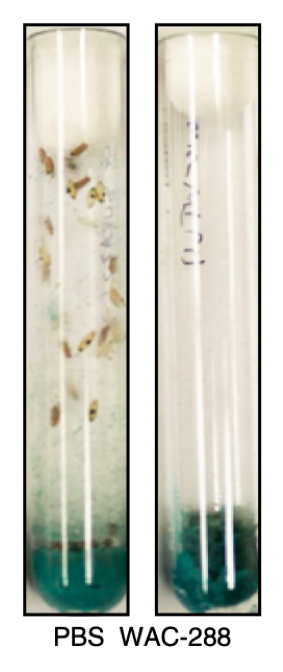
Microblog
Uncovering the Dark Side of Insect-Bacteria Interactions
 Microbial symbionts exemplify diverse and extraordinary interkingdom interactions. While we may be most familiar with human gut microbes, there are fascinating associations between insects and bacteria. In particular, members of the largest bacterial phyla, actinomycetes, commonly associate with diverse insects such as honeybees and silkworms (Chevrette et al., 2019). Actinomycetes secrete certain chemical compounds that protect the insects’ food and offspring from infection (Kaltenpoth et al.,2005; Scott et al., 2008). Despite the fact that other secreted compounds can be toxic to insects, researchers had never identified a partnership where actinomycetes inflicted harm on an insect. Recently, a darker side of actinomycete-insect interactions piqued the interest of Dr. Justin Nodwell’s team at the University of Toronto. Led by Louis Ho, they set out to explore toxic chemical interactions between the actinomycetes genus Streptomyces and the common fruit fly, Drosophila melanogaster.
Microbial symbionts exemplify diverse and extraordinary interkingdom interactions. While we may be most familiar with human gut microbes, there are fascinating associations between insects and bacteria. In particular, members of the largest bacterial phyla, actinomycetes, commonly associate with diverse insects such as honeybees and silkworms (Chevrette et al., 2019). Actinomycetes secrete certain chemical compounds that protect the insects’ food and offspring from infection (Kaltenpoth et al.,2005; Scott et al., 2008). Despite the fact that other secreted compounds can be toxic to insects, researchers had never identified a partnership where actinomycetes inflicted harm on an insect. Recently, a darker side of actinomycete-insect interactions piqued the interest of Dr. Justin Nodwell’s team at the University of Toronto. Led by Louis Ho, they set out to explore toxic chemical interactions between the actinomycetes genus Streptomyces and the common fruit fly, Drosophila melanogaster.
Given the uncharted nature of characterizing the toxicity of Streptomyces compounds to insects, the researchers first asked how prevalent these chemicals are in nature. To answer this, they generated small molecule extracts from 56 uncharacterized wild isolates of Streptomyces. These extracts were added to the food of fruit fly larvae whose development was then monitored for 14 days. Extracts from 7 of the Streptomyces species tested completely inhibited larval development, ultimately resulting in death. Astonishingly, these results were reproduced when the extracts were replaced with spores from those Streptomyces species. This discovery was particularly exciting because it indicated the spores themselves could act as a delivery vehicle for the toxic compounds. Further, they observed the same phenomenon when other Drosophila species were tested, indicating that the Streptomyces chemical arsenal has broad spectrum toxicity against fruit flies in general.
Eager to uncover the most potent insecticidal Streptomyces compound, the researchers performed bioactivity-guided fractionation coupled with tandem mass spectrometry on the most toxic Streptomyces strain, WAC-288 (Figure 1). Pairing these results with whole genome sequencing of WAC-288 indicated that the compound of interest was cosmomycin D. This was confirmed when the spores of a laboratory-generated, cosmomycin D-defective WAC-288 no longer killed fruit fly larvae. Additionally, when the same pipeline was performed with a different species, S. avermitilis, they identified another compound, avermectin, which was capable of rapid larval killing. Overall, these results suggest that Streptomyces capable of producing insecticidal metabolites are relatively common.
Cosmomycin D is a known DNA intercalator; therefore, the researchers predicted that it kills larvae by activating apoptotic cell death (Fuchs & Steller, 2011). To confirm this, they fed larvae wild-type or cosmomycin D-defective WAC-288 spores and measured apoptosis initiation in the gut by staining with an antibody that binds the Drosophila homolog of caspase-9, Dronc. Strong Dronc staining was only seen in larvae fed with wild-type spores, indicating that cosmomycin D causes cell death in the gut. Consistent with avermectin having a different mode of action, Dronc staining was not seen in larvae fed with S. avermitilis spores.
Another volatile compound produced by WAC-288 and other actinomycetes is 2-methylisoborneol (2-MIB). Recently, low concentrations of 2-MIB were found to subtly attract insects (Becher et al., 2020). Therefore, the researchers hypothesized that WAC-288 might attract flies through secretion of 2-MIB. In a food choice experiment, 76% of flies chose the source containing wild-type WAC-288 over a control, whereas only 55% of flies chose the food source containing 2-MIB-defective WAC-288 over a control. Consistent with their previous findings, the researchers found no viable larvae in the WAC-288-containing food source condition indicating that fruit flies are attracted to Streptomyces through 2-MIB production despite the ultimate demise of their offspring via toxic specialized metabolites.
This research provides a new perspective on actinomycete-insect partnerships and challenges the long-held belief that the insect is always benefitted. These compelling findings will hopefully lead to more extensive mapping of the Streptomyces chemical arsenal used to help or hinder their invertebrate partners. Overall, this discovery provides an interesting perspective on the evolutionary history between these organisms and is sure to fascinate microbiologists and entomologists alike.
Primary Research Article and Figure Citation:
Ho, L.K. et al. Chemical entrapment and killing of insects by bacteria. Nat. Commun. 11, 4608 (2020).
Other References:
Becher, P. G. et al. Developmentally regulated volatiles geosmin and 2- methylisoborneol attract a soil arthropod to Streptomyces bacteria promoting spore dispersal. Nat. Microbiol. 5, 821–829 (2020).
Chevrette, M. G. et al. The antimicrobial potential of Streptomyces from insect microbiomes. Nat. Commun. 10, 1–11 (2019).
Fuchs, Y. & Steller, H. Programmed cell death in animal development and disease. Cell 147, 742–758 (2011).
Kaltenpoth, M., Göttler, W., Herzner, G. & Strohm, E. Symbiotic bacteria protect wasp larvae from fungal infestation. Curr. Biol. 15, 475–479 (2005).
Scott, J. J. et al. Bacterial protection of beetle-fungus mutualism. Science 322, 63–63 (2008).

Cowen LAb
Posted on : 25/11/2020 9:00 PM
Liked this post?
Click the social media icons on the left to share!
Have anything to say? Comment below!



